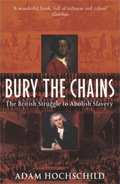You are here: Reports » Phase 1: media » Reviews » Bury the Chains...
Bury the Chains: The British Struggle to Abolish Slavery
Author: Adam Hochschild
Year: 2007
Publisher: London. Pan.

Bury the Chains is an analysis of the workings of the abolition movement in Britain in the late 1700s and early 1800s. The book examines the abolitionists as the first human rights campaigners in the modern world and draws comparisons with today's struggles for democracy and a universal declaration on human rights with the fight to abolish the slave trade in Britain and its colonies in 1807.
The book is a celebration of the abolition campaign, of how a few individuals made the general populace in England feel a sense of empathy for the enslaved peoples of Africa. Hochschild (2007: 1) lauds this achievement as a substantial moment in human history, opening the work with the statement, 'to understand how momentous was the beginning, we must picture a world in which the vast majority of people are prisoners. Most of them have known no other way of life.' Hochschild dismisses the scholarship which has emerged since Williams Capitalism and Slavery which regarded the economic perspective over the humanitarian in the cause of abolitionism and emancipation. Hochschild even goes so far as to perhaps decry the resistance and rebellion in overturning slavery and the slave trade, choosing instead to focus on the mobilisation of the British public. 'Slaves and other subjugated people have rebelled throughout history; but the campaign in England was something never seen before: it was the first time a large number of people became outraged, and stayed outraged for many years, over someone else's rights' (Hochschild 2007: 5). It is the peculiar faculty of human empathy and the success of the abolitionists to excite this sense that Hochschild assesses. The great success described in the book was the ability of the abolitionists to draw connections between the near and the far, creating an imaginative bridge between two worlds which would otherwise remain distant (Hochschild 2007: 6). This was achieved according to Hochschild by developing a political lobbying group which was the forerunner of the political machines that operate in western democracies today. Hochschild (2005: 128) even describes Wedgewood's image of a supplicant slave with the motto, 'Am I not a man and a brother?' as a, 'forerunner of the political lapel buttons we use today.'
The attention of the book is therefore is wholly on the abolition movement as a highly organised, political group, rather than as a collection of individuals motivated by religious concerns. Just as others have previously privileged the economic over the humanitarian, Hochschild favours the political over the religious. Religion is painted as complacent in Bury the Chains, inactive in comparison to the momentum of political will. Hochschild (2007: 29) indeed pours scorn on the notion of Christianity impacting upon the agenda with subtle criticisms. The book states, regarding John Newton, 'for more than thirty years after he left the slave trade, during which time he preached thousands of sermons, published half-a-dozen books and wrote, 'Amazing Grace' and 279 other hymns, Newton said not a word in public against slavery' (Hochschild 2007: 77). The political mode of operating by the abolitionists is shown by Hochschild as highly influential in the Reform Bill of 1832 as well as subsequent trade union movements throughout the nineteenth century. Both the means of achieving the ends and the subject itself was recalled by others as a means of advancing their claims; 'again, and again for domestic reform of all sorts drew on the antislavery movement as a tactical model and on slavery itself as a powerful metaphor (Hochschild 2007: 352-353).
Bury the Chains therefore attempts to reclaim the victory of abolitionism as a political achievement rather than its traditional perception as a product of the fervent religiosity of the proponents of the 1807 Act.
